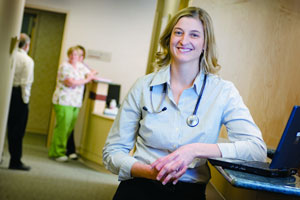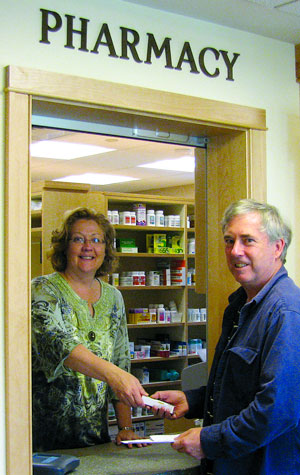Aug 20, 2014
Rural Patient Centered Medical Homes Achieve New Standards

Transforming a primary care practice into a patient centered medical home (PCMH) is no easy feat for rural safety net providers, which typically have large underserved patient populations, according to John Gale, a Research Associate at the University of Southern Maine's Maine Rural Health Research Center. Despite the challenges, two rural safety net providers on opposite sides of the United States have proven that PCMH is not only achievable, but that it also improves patient health outcomes.
Crete Area Medical Center Physicians' Clinic (CAMC), a Rural Health Clinic (RHC) in Crete, Nebraska, and Ammonoosuc Community Health Services (ACHS), a New Hampshire Federally Qualified Health Center (FQHC) with five locations, are among very few safety net providers that have achieved Level 3 PCMH recognition. Level 3 is the highest recognition available by the National Committee for Quality Assurance (NCQA). CAMC and ACHS achieved all three levels within a year of beginning the process and were recertified for Level 3 last year. Recertification is required every three years and each recertification involves adherence to more stringent standards and outcomes than previously required.
Only about 10 percent of American primary care practices are recognized as PCMH facilities by NCQA, which has the nation's largest certification program. NCQA's performance measurement tools and standards required for PCMH recognition are aligned with the American College of Physicians, the American Academy of Family Physicians, the American Academy of Pediatrics and the American Osteopathic Association.
Rural safety net providers face greater challenges than urban counterparts, such as staffing shortages, limited resources and patient populations that are low-income, often uninsured and less likely to become engaged in their personal care, according to Gale's research (a PowerPoint presentation, Are Rural Health Clinics Ready to Function as Patient Centered Medical Homes, details some of Gale's research, which is set to be published as a future report).
"The medical home not only requires improved quality of care with cost controls, but it engages patients and families in the decision making and change process," Gale explained. "If patients don't understand the need to change and buy into it, the medical piece isn't going to be effective."
Improving Patient Outcomes
In Saline County, Nebraska, patients are buying into it. Ninety-four percent of CAMC patients with diabetes, high cholesterol and/or hypertension are in compliance with their chronic disease management plan. The number of Saline County residents diagnosed with these three diseases is higher than national averages, but the PCMH model is successfully contributing to reductions in hospitalizations and emergency visits among these patients.
"Adhering to follow-up care is important because if patients with chronic disease are coming in for appointments, you get more face time with them to help encourage, support and treat them for these conditions," CAMC Outpatient Clinical Manager Stephanie Hollman said.
From 2011 to 2013, 30-day hospital readmissions were reduced from 5 percent to 2.3 percent. In 2013, heart failure readmissions were reduced by 10 percent. CAMC data tracks patients monthly; for instance, in April, 84.3 percent of patients' with hypertension were at 140/90 or better compared to 35.3 percent nationally.
"We have seen the benefits of the medical home model through increases in preventative screenings too, which leads to better health for the community," Hollman noted. For instance, 62 percent of women 21-64 had pap smears and 70.8 percent had mammograms in recommended time frames.

ACHS is a recipient of the Patient Safety and Clinical Pharmacy Services Collaborative award established by HRSA to recognize safety net providers that are improving quality care through the integration of health care providers and increased use of clinical pharmacy services. Director of Patient Services Teresa Brooks said ACHS has implemented strategies directly impacting specific areas. For instance, one of the goals was improvement in identification and prevention of adverse events. A simple, but very effective change, Brooks said, was identifying all patients using 15 or more active medications and providing medication education and usage instructions in patient friendly language, such as "hypertension" being referred to as the more recognizable "high blood pressure." Because abbreviations were confusing patients, they were eliminated from all prescription containers.
Fully Implementing Electronic Health Records
As PCMH recognition standards have become more closely aligned with the Center for Medicare and Medicaid Services' Meaningful Use criteria, Gale said the use of an electronic health record (EHR) has become more important. His study indicated 59 percent of RHCs have an EHR in use and 16 percent are in the purchase or implementation stage. Twenty-five percent still have not implemented an EHR. Level 1 PCMH can be achieved without EHRs; however, it becomes more necessary for Level 2. Level 3 requires a fully functional EHR system.
Both CAMC and ACHS had an advantage in that they had already implemented EHRs prior to beginning the PCMH process.
"We added EHR in 1996 and began moving toward the medical home model in 2008 as a member of the New Hampshire Multi-Stakeholder Medical Home Pilot," Brooks said. "In addition to having EHR, Level 3 was made somewhat easier by the fact that FQHCs depend on grant funding, which has made our staff accustomed to collecting and managing information. It's a way of life for us and it's a major part of Level 3. Some of the additions we made with Level 3 were a patient portal and electronic prescribing."
"We went live with our EHR about a year before we were recognized, and it was with the addition of a robust patient registry that we were able to then meet Level 3 standards," Hollman commented. "There is no doubt that having EHR allows for better tracking of labs and medications, which is part of NCQA's PCMH standards. We contract with a third party to maintain the disease registry."
CAMC implemented EHRs for diabetes education programming, disease monitoring and preventative screenings prior to PCMH status. Further developments have included patient benefits such as being able to view laboratory results on a web portal in real time and access information about their medications.
"RHCs, as a group, seem to do better on recognition standards related to the use of EHRs for recording patient demographic and clinical data as well as lab and medication tracking," Gale said. "They do less well on issues related to improving timely access to care, exchanging clinical information, developing care management services, monitoring referrals, and implementing continuous quality improvement and culture of quality activities.
Adapting to Level 3
With Level 3, Hollman said, CAMC focused its efforts on enhanced patient access, managing patient populations, planning and managing care, providing community resources, coordinating care with other facilities and improving performance.
CAMC and ACHS added extended evening and Saturday hours to improve patient access. Hollman said they also have a midlevel provider accessible 24 hours a day. To improve appointment attendance, patients receive an advance reminder the day prior to their appointment. ACHS's Patient Navigators (PNs) help patients find resolutions for issues related to access, such as transportation difficulties for appointments or lack of money for prescribed medications.

"PCMH requirements, such as increasing patient access, are difficult for small clinics too," Gale noted. "Even ensuring access to a patient's identified provider and care team is difficult when you're talking about a small rural physician office."
The PNs are essential members of the ACHS care team, Brooks said. "Our PNs handle the whole gamut of care coordination that the provider may not have time or resources to do. PNs work directly with both the patient and the provider. They keep up to date on the patient's chronic care reports, performance measures and care management to ensure that each patient's care is very individualized."
ACHS already had care teams in place and tracked referrals, but Level 3 encouraged changes such as improving PN care forms and putting policies and procedures in better perspective, Brooks said.
CAMC's planning and managing care adaptations have included additions such as regular age-based interventions for annual physical exams, immunizations from birth to college age for protection from preventable conditions and illnesses, and scheduled adult screenings for chronic disease and cancers of the colon, breast and cervix.
Behavioral health and oral care are included in the scope of PCMH primary care. Having behavioral health under the same roof decreases stigma and improves patient participation because primary care staff use the warm hand-off approach to connect behavioral health counselors to patients, Brooks said. Working with the New Hampshire Oral Health Coalition, ACHS and other community partners are implementing an oral health educational program. A dentist, hygienist and dental assistants will be located in a dental facility being constructed at the Littleton site.
"From our patients' perspective, achieving Level 3 was almost seamless because they didn't necessarily see huge changes," Brooks commented. "We do have a patient portal now and that's been exciting for them because they can access their medical records."
"Our main challenges for PCMH recognition came in terms of cost and data," Hollman said. "There is added cost related to staffing needs for a Medical Home, which is different from that of a traditional clinic model. To be a Medical Home, you need to be able to abstract large quantities of data too. That requires a really good patient registry to be able to query Medical Home standards through NCQA."
CAMC was the first Nebraska rural health facility to achieve PCMH recognition and only the fourth practice in the state to achieve Level 3. Located in a primarily agricultural area, CAMC serves about 14,500 residents. Approximately 25 percent of the patient population is Hispanic and many speak no English. ACHS serves 10,000 primarily Caucasian people living in 26 communities in northern New Hampshire. ACHS has offices at Littleton, Franconia, Warren, Whitefield and Woodsville.
Moving Toward the PCMH Model
Growing shortages of primary care providers, the increasing prevalence of chronic disease, fractured and disconnected delivery systems, the need to better manage patient care and the opportunity to refocus the central role of primary care are all among factors contributing to the push for rural facilities to adopt the PCMH model, according to Gale. "Many insurers still don't pay for the time and care coordination components, and these requirements are not insignificant in terms of people and resources," he commented. "Another drawback for these facilities is the time and resource heavy commitments that are required such as data collection, care management and documentation."
Reimbursement is improving in some areas. According to The Patient-Centered Medical Home Initiative report, CMS is sponsoring a number of projects to transform primary care, including an Advanced Primary Care Demonstration Program supporting 500 FQHCs to become PCMHs. The 2010 Benefits of Implementing the Primary Care Patient-Centered Medical Home cites numerous state PCMH projects and examples of private insurers that are beginning to support PCMH reimbursements.
Even as reimbursement incentives increase, Gale believes RHCs, which operate more like small physician practices, will continue to struggle more than FQHCs. Gale said FQHCs receive better Medicare and Medicaid reimbursement and are eligible for support in obtaining PCMH recognition through the Health Resources and Services Administration's Patient-Centered Medical/Health Home Initiative.
"However, it's still important for rural facilities to continue to prepare for the future even if reimbursement issues haven't been fully resolved," he asserted. "PCMH is viewed by policymakers as a way of preparing primary care practices for patient transformation by addressing issues relating to improving value, increasing access and involving patients in their own decision making. As we move toward value-based healthcare, the patient centered medical home becomes an external validation that clinics are on top of their game. Clinics that can show they are doing a good job will become more valuable and more likely to be included in ACOs (accountable care organizations) or provider panels."
Gale's advice for safety net providers considering the move toward PCMH recognition? "Target key clinical and operational areas and develop protocols and procedures that directly impact clinic performance such as focusing on meaningful use of an EHR, implementing continuous quality improvement systems, enhancing patient access, improving practice performance on key metrics, and publicly reporting quality data—things that make sense regardless of whether or not you achieve the PCMH model. Moving in that direction will position your clinic better for the future."
Back to: Summer 2014 Issue
